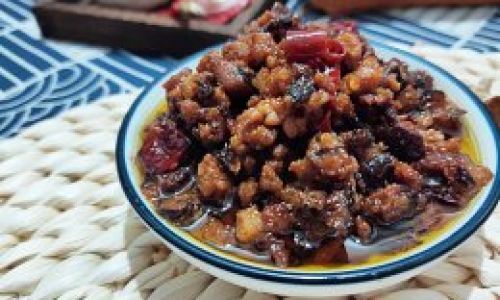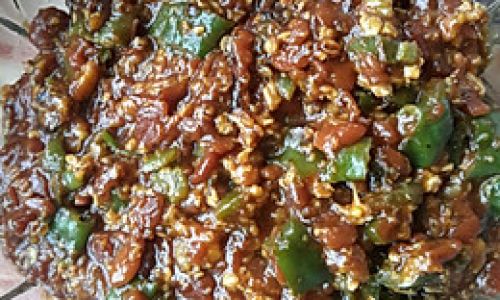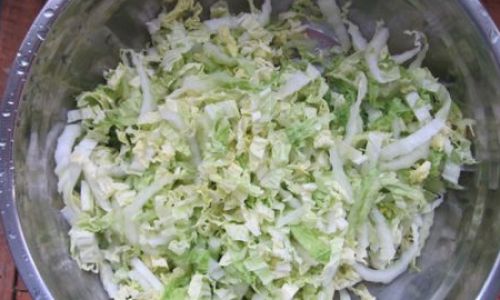Table of content
Fried bean paste, a staple in many Asian cuisines, is a versatile condiment that adds depth, umami, and a hint of spice to dishes. Often referred to as the “soul” of Sichuan cooking, this savory paste is a cornerstone of recipes like mapo tofu, twice-cooked pork, and stir-fried vegetables. While store-bought versions are convenient, crafting your own fried bean paste allows you to control the ingredients, adjust the spice level, and tailor the flavor to your palate. This article delves into the traditional method of preparing fried bean paste, offering tips, variations, and insights to help you achieve restaurant-quality results at home.

The Essence of Fried Bean Paste
Fried bean paste, or doubanjiang in Mandarin, is a fermented mixture of soybeans, chili peppers, salt, and sometimes wheat flour. The fermentation process, which can span several months, develops its signature rich, salty, and slightly tangy flavor. However, the term “fried bean paste” often refers to a cooked variation where the fermented base is sautéed with aromatics, spices, and oil to mellow its raw intensity and intensify its savory notes. This cooked version is less pungent than raw fermented bean paste and boasts a caramelized depth that elevates both simple and complex dishes.
Ingredients: Building Blocks of Flavor
Creating exceptional fried bean paste starts with selecting high-quality ingredients. Here’s a breakdown of the key components:
-
Fermented Black Beans (Douchi): These are the foundation of the paste. Available in Asian markets, they are soybeans fermented with salt and enzymes, resulting in a pungent, salty flavor. Rinse them thoroughly to remove excess salt before use.

-
Aromatics: Garlic, ginger, and shallots form the flavor backbone. Fresh, finely minced garlic adds pungency, while ginger imparts a warm, citrusy note. Shallots or yellow onions contribute sweetness.
-
Spices: Sichuan peppercorns provide a numbing tingle, while dried chili flakes or fresh red chilies add heat. Adjust the quantity based on your spice tolerance.
-
Oil: Use a neutral oil with a high smoke point, such as peanut, vegetable, or canola oil. For a richer flavor, opt for sesame oil or lard (traditional in some regions).

-
Sweetener: A touch of sugar or rock sugar balances the saltiness and enhances caramelization.
-
Optional Additions:
- Doubanjiang: For an extra layer of complexity, mix in store-bought chili bean paste.
- Mushrooms: Dried shiitake mushrooms, rehydrated and minced, add umami.
- Meat: Ground pork or beef can be incorporated for a heartier paste.
Equipment: Tools for Precision
- Wok or Heavy-Bottomed Pan: Essential for even heat distribution and stir-frying.
- Food Processor or Mortar and Pestle: To finely chop or grind the fermented beans and aromatics.
- Spatula: Use a heat-resistant spatula to stir continuously and prevent burning.
- Storage Containers: Glass jars with airtight lids for preserving the paste.
Step-by-Step Preparation
Preparing the Fermented Beans
- Rinse and Drain: Place the fermented black beans in a colander and rinse under cold water to remove excess salt. Drain thoroughly.
- Mash or Chop: Transfer the beans to a mortar and pestle or food processor. Pulse until they form a coarse paste. Avoid over-processing, as some texture is desirable.
Preparing Aromatics and Spices
- Mince Garlic and Ginger: Peel and finely mince 6–8 garlic cloves and a 2-inch piece of ginger.
- Slice Shallots: Thinly slice 2–3 shallots or ½ a small yellow onion.
- Toast Spices: In a dry pan, toast 1 tablespoon of Sichuan peppercorns over low heat until fragrant. Grind them coarsely using a mortar and pestle.
Sautéing the Base
- Heat the Oil: Pour ¼ cup of oil into a wok and heat over medium-high flame until shimmering.
- Fry Aromatics: Add the minced garlic, ginger, and shallots. Stir-fry for 2–3 minutes until golden and aromatic.
- Add Spices: Sprinkle in the ground Sichuan peppercorns and 1–2 tablespoons of dried chili flakes (adjust to taste). Stir for 30 seconds to release their oils.
Cooking the Bean Paste
- Introduce the Beans: Add the mashed fermented beans to the wok. Reduce the heat to medium-low to prevent burning.
- Stir Continuously: Fry the mixture for 15–20 minutes, stirring constantly. The paste will darken, thicken, and release a toasty aroma.
- Adjust Seasoning: Stir in 1 tablespoon of sugar and 1 tablespoon of soy sauce (optional). Taste and adjust salt or spice as needed.
Cooling and Storing
- Transfer to Jars: Allow the paste to cool completely before transferring it to sterilized glass jars.
- Storage: Refrigerate for up to 3 months. The flavor will mellow and deepen over time.
Tips for Perfect Fried Bean Paste
- Oil Temperature: Maintain medium-low heat to avoid scorching the beans. Patience is key—slow cooking develops complexity.
- Consistency: Aim for a thick, spreadable texture. If the paste is too dry, add a splash of oil or water.
- Customization: Experiment with additions like star anise, cinnamon, or fermented bean curd for unique twists.
- Vegetarian Variation: Substitute meat with minced mushrooms or tofu for a plant-based version.
Serving Suggestions
Fried bean paste is incredibly versatile. Use it as:

- A Stir-Fry Base: Sauté vegetables or proteins with a spoonful of paste for instant flavor.
- Noodle Sauce: Mix with soy sauce, vinegar, and sesame oil for a quick noodle dressing.
- Marinade: Rub onto meats before grilling or roasting.
- Dipping Sauce: Thin with broth or water and serve with dumplings or spring rolls.
Health Benefits
While fried bean paste is high in sodium, it offers nutritional perks:
- Protein and Fiber: Fermented soybeans are rich in plant-based protein and dietary fiber.
- Probiotics: The fermentation process introduces beneficial bacteria, aiding digestion.
- Antioxidants: Chili peppers provide vitamin C and capsaicin, known for its anti-inflammatory properties.
Common Pitfalls and How to Avoid Them
- Burnt Flavor: If the paste turns bitter, reduce the heat immediately and stir vigorously.
- Grainy Texture: Ensure beans are mashed thoroughly before cooking.
- Excessive Saltiness: Rinse beans well and balance with sugar or acidic ingredients like vinegar.
- Short Shelf Life: Always use clean utensils and refrigerate to prevent spoilage.
Regional Variations
- Sichuan Style: Emphasizes numbing Sichuan peppercorns and bold chili heat.
- Hunan Style: Incorporates smoked chili peppers and less fermentation time.
- Cantonese Style: Milder and sweeter, often with added dried shrimp or oyster sauce.
Conclusion
Crafting fried bean paste at home is a labor of love that rewards you with a pantry staple of unparalleled flavor. Whether you prefer it fiery, savory, or subtly sweet, this recipe provides a flexible foundation to explore. Experiment with add-ins, adjust the spice level, and savor the satisfaction of creating a condiment that transforms ordinary meals into culinary masterpieces. With practice, you’ll master the delicate balance of umami, heat, and depth that defines this beloved Asian ingredient.
This comprehensive guide ensures that even novice cooks can achieve authentic fried bean paste, while offering seasoned chefs room to innovate. By understanding the interplay of ingredients, heat, and time, you’ll unlock the secret to elevating your home-cooked dishes with this time-honored condiment.







0 comments